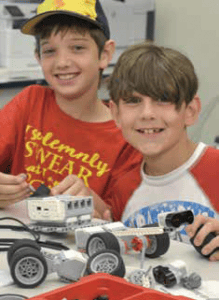
With more than 60 years of experience in the world of education, Hebrew Academy of Tidewater decided this year to pilot a one-week summer camp program—Camp Creation Station. This new camp utilized ideas and activities from HAT’s very strong STEAM curriculum (Science, Technology, Engineering, Arts, and Math).
HAT’s creative camp team came together earlier this year. Rabbi Yitzchak Menda, Judaic Studies director, who also runs HAT’s coding and robotics clubs; Rashi Brashevitzky, Judaic teacher and director of Chabad’s Camp Gan Izzy; and Melanie Columbus, HAT’s media specialist, who formerly ran an arts program through MOCA, worked together to create Camp Creation Station. The goals were for the kids to work on open-ended projects utilizing their creativity and STEAM skills, and of course, to have fun.
On Monday, June 12, campers arrived and the challenge was set. The students were tasked with putting together a city in which they would design a building, create and paint the background, and build robots to work in the city. Students discovered that they already possessed extensive building experience. Many had been building for years with Legos, sand castles at the beach, and forts at home. They learned, however, that in order to design a building, they would need a design and structural plan.
Students were divided into two age groups, grades 1–3 and grades 4–6, and were engaged in a plethora of activities throughout the day. Two HAT seventh grade alumni, Abbey Seeman and Tal Zach, volunteered to assist for the week.
Activities included building, art, robotics, swimming, and outside play. During the week, the students also participated in robotics challenges to test their work before creating the final product.
Menda says he was thrilled with the program’s outcome. “The camp was amazing, and the kids had a great time. We are already thinking about ways to advance the program next year. We are hoping to be able to open the camp to the broader community, experiment with different materials, and create an engaging scenario for the students.”
The students, Menda says, “did an incredible job problem solving, collaborating and innovating.” By the end of the week, the students had created cities that included a variety of buildings, and even a water park.
– Carin Simon
